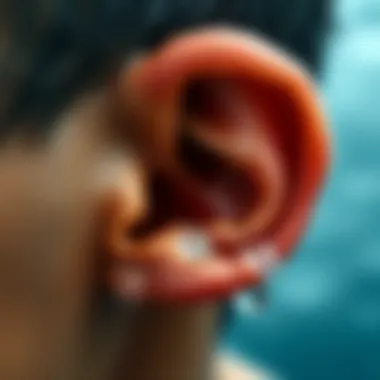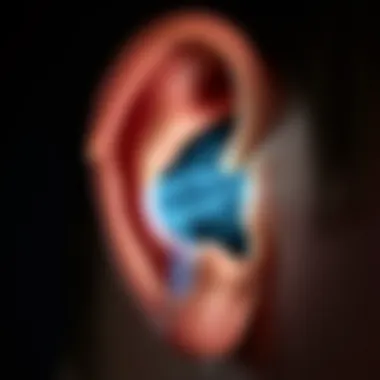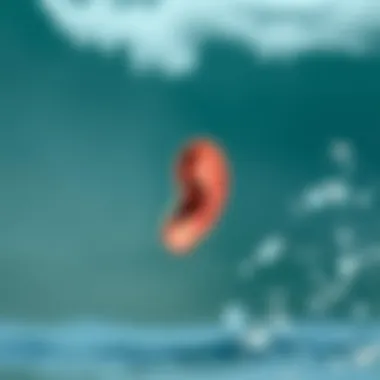Effective Strategies for Releasing Water in the Ear


Intro
Water getting trapped in the ear is a common annoyance, especially for those who love the ocean, whether they’re catching waves or just wading by the shore. When water sits stubbornly in the ear canal, it can lead to discomfort, temporary hearing loss, and, in some cases, infections. It’s not just an irritating experience; it can also distract you from enjoying your time in the water.
But what causes this problem in the first place? Understanding the mechanics of ear canals and how water gets trapped is critical. Ear canals are shaped somewhat like an ‘S’, making it easy for water to linger, especially after swimming or showering. This can become a concern, especially for surfers, who are repeatedly doused in waves.
In the following sections, we’ll dive into practical strategies for easy release of water trapped in the ear, discuss the symptoms to watch out for, and highlight techniques that will keep your ears clear and your water fun uninterrupted. Let’s get started.
Prologue
Water trapped in the ear can create significant discomfort and lead to complications if not addressed promptly. The ability to effectively release water from the ear is crucial not only for surfers, who frequently encounter such issues, but also for anyone participating in aquatic activities. This article aims to provide a comprehensive guide that focuses on various strategies to alleviate the discomfort and prevent potential problems related to water accumulation in the ear.
Understanding Ear Mechanics
To appreciate how water gets trapped in the ear, it’s essential to have a basic understanding of ear mechanics. The human ear is divided into three main parts: the outer ear, middle ear, and inner ear. The outer ear includes the ear canal, which serves as a conduit for sound waves to reach the eardrum. The middle ear contains the eardrum and three tiny bones that aid in sound transmission, while the inner ear houses the structures necessary for hearing and balance.
When engaging in activities like swimming or surfing, water can easily enter the ear canal. If the eardrum doesn't create enough pressure difference to push the water out, it can lead to a sensation of fullness or discomfort. Factors like anatomy, positioning while submerged, or the presence of earwax can also play a role in trapping water. Understanding these mechanics can empower individuals to take appropriate actions for relief.
Common Causes of Water Accumulation
Water accumulation in the ear can occur for various reasons. One of the primary culprits is the anatomy of the ear itself; some people have ear canals that are slightly more horizontal, making it easier for water to get stuck. Other common causes include:
- Swimming: Submerged activities can easily lead to water entering the ear canal, especially if the movements are vigorous or prolonged.
- Bathing: It's not uncommon for water to inadvertently splash into the ears while washing.
- Diving: The pressure changes associated with diving can contribute to water retention in the ear.
- Yanking: Sudden removal of earplugs or headphones can sometimes force water deeper into the ear.
Not addressing these causes promptly might lead to complications such as infections or discomfort. Being able to recognize these scenarios allows individuals to take preemptive measures.
"Water in the ear, while often considered a trivial inconvenience, can lead to significant issues if left unattended."
Ultimately, knowing how the ear functions and what might cause water to linger is fundamental for anyone eager to enjoy water activities without the anxiety of lingering discomfort.
Recognizing Symptoms
Understanding the symptoms of water trapped in the ear is crucial for surfers and those who regularly engage in aquatic activities. Recognizing these symptoms early can prevent complications such as infections or prolonged discomfort. Often, the body provides signals that hint at the presence of trapped water, and being attentive to these signs can lead to timely intervention. Moreover, acknowledging when the situation worsens is essential. This section will highlight typical signs to watch out for and when intervention is needed.
Typical Signs of Water Trapped in the Ear
When water becomes trapped in the ear, several distinct symptoms may arise. These symptoms can vary but often include:
- Feeling of fullness or pressure: This can be an immediate indication that something is amiss.
- Muffled hearing: Sounds may seem muted, making it difficult to hear clearly.
- Discomfort or pain: Some individuals may feel mild to moderate pain, especially if water sits close to the eardrum.
- Tinnitus: Ringing or buzzing in the ear may occur.
- Fluid sensation: A sloshing sound can often be noticed when moving the head.
When experiencing these symptoms, particularly after swimming or diving, it may just be water, but paying heed to these signs is critical to safeguard your ear health.
When Symptoms Require Attention
While many cases of water retention resolve naturally, some situations demand medical insight. Knowing when to seek help can make all the difference. Here are some instances when medical attention is warranted:
- Persistent pain: If discomfort extends beyond a few hours, it might signal an underlying issue.
- Hearing loss: A sudden drop in your hearing capability, especially accompanied by other signs, must prompt a consultation.
- Signs of infection: These may include fever, fluid discharge, or redness around the ear.
- Prolonged symptoms: If the feeling of fullness or muffled hearing lasts over 24 hours, it’s wise to consult a healthcare provider.
"Listening to your body is key. If the usual remedies are falling short and symptoms linger, don't hesitate to reach out for professional advice."
Acting quickly when symptoms trigger concern can facilitate recovery and prevent complications. Remember, aquatic activities should be enjoyable—don't let discomfort ruin the experience.
Basic Release Techniques


Understanding the basic techniques for releasing water trapped in the ear is crucial, especially for those who spend a lot of time in aquatic environments like surfers and lifeguards. Water buildup may lead to discomfort or even ear infections if not addressed properly. These techniques are simple yet effective ways to help clear the ear canals safely and easily, and they don't require specialized equipment or medical intervention.
Gravity Method
Technique Overview
The gravity method is one of the most straightforward approaches to releasing trapped water. It involves changing your head position to allow gravity to aid in the drainage of the water. By tilting your head to one side and gently pulling on your earlobe, you help create a clear path for the water to exit. This method stands out because it essentially uses gravity to your advantage—a natural force that’s always at play.
What makes this choice popular is its simplicity and effectiveness. It doesn't require any tools, and anyone can do it with no training. The unique aspect of this method is that it's both low-risk and non-invasive, often providing immediate relief.
Best Practices
When using the gravity method, it's vital to follow some best practices to maximize its effectiveness. Position yourself in a comfortable place where you can control your head movements. Tilt your head sideways to the ear with the water, then hop gently on one foot or perform a series of quick jaw movements. These actions can enhance the chance of water escaping. The key characteristic of this technique is that it encourages a natural release, making it an appealing option.
Another advantage is that it’s suitable for all ages, from children to adults. However, a side note to consider is that the method might not work if the water is trapped too deeply within the ear canal. If that’s the case, additional strategies might be necessary.
Jaw Movements
Chewing
Chewing is not only about satisfying hunger; it can also be an effective method for dealing with water trapped in the ear. The repeated motion of the jaw can help to open the Eustachian tube, potentially allowing the trapped water to drain more easily. It’s a natural and instinctive action during meals, making it a convenient choice.
The central appeal of chewing lies in its accessibility. You can simply pop in a piece of gum or even a snack to trigger this action. The advantage here is that the movement enhances airflow in your ear passages, which may facilitate the release of water quickly. However, while effective, it may not work for everyone and could require a little persistence.
Yawning
Yawning is another natural bodily function that can help alleviate the feeling of fullness due to trapped water. This simple act can also equalize pressure in the ears and can be particularly effective after flying or diving.
The key benefit of yawning is its ability to open the Eustachian tube, promoting drainage. It's a beneficial choice because it’s a reflex action that’s usually effortless to initiate. What’s unique about yawning is that it often occurs when you're tired or bored, so it can happen spontaneously anytime during the day. However, reluctance to yawn can limit its effectiveness; if you're not feeling tired, it may be harder to invoke this method.
The Vacuum Technique
Method Explanation
The vacuum technique requires creating a vacuum effect using your handheld device—often your palm or a wet towel—against your ear. The principle is to gently pull away from your ear canal while creating a seal, allowing any trapped water to be sucked out by the pressure difference. This method is particularly useful for those who may not find success using gravity techniques alone.
What makes this method enticing is its potential for rapid relief. Unlike earlier techniques, it focuses on creating a pressure differential, which can yield results more quickly. However, it's crucial to perform this method gently, as excessive force can lead to discomfort or injury.
Points of Caution
While the vacuum technique can work wonders, it’s imperative to approach it with caution. Too much pressure or incorrect application can lead to ear damage, possibly aggravating the situation instead of alleviating it. The key characteristic here is the importance of moderation; one should be careful not to overdo it.
One of the notable advantages of this method is its versatility—it can be done in a variety of settings. However, this technique isn’t recommended for individuals who have existing ear conditions or who have recently experienced ear trauma. In such cases, seeking professional advice is a wise course of action.
By understanding and applying these basic release techniques, one can manage the discomfort associated with trapped water effectively. They empower individuals to take charge of their ear care in simple yet profound ways.
Advanced Techniques
When water gets stuck in the ear, some situations call for an advanced touch. Unlike basic methods such as gravity or jaw movements, advanced techniques often offer more targeted solutions that can help alleviate discomfort effectively. Understanding how to leverage heat, eardrops, and specific cleaning methods can be invaluable for individuals who frequently find themselves in watery environments. These techniques not only allow for prompt relief but they also highlight the importance of proactive ear care.
Using Heat for Relief
Applying Warm Compress


Using a warm compress is one of the simplest yet effective methods to relieve trapped water in the ear. This technique works by relaxing the ear's muscles and encouraging drainage. The key characteristic of a warm compress is its ability to provide gentle heat, which can stimulate blood flow and create a soothing effect. People often choose this method because it's readily available—most homes have a towel or a heat pack on hand.
What makes the warm compress particularly beneficial is its safety; unlike chemicals or invasive techniques, it poses minimal risks. However, one must ensure that the compress isn't too hot, as this could lead to burns or discomfort. The unique feature of a warm compress is its dual action: it not only aids in releasing water but also decreases any ear alarm that might be causing concern.
Safety Considerations
While warm compresses are a great go-to, safety considerations are vital. One major aspect is ensuring that the heat is applied correctly, preferably for no longer than 20 minutes. Leaving it on too long might result in overheating, which can complicate matters rather than solve them.
It's also important to check for skin sensitivity. If any irritation occurs, ceasing use immediately is imperative. The unique characteristic of understanding these safety precautions is fundamental because it ensures that individuals can enjoy the benefits without incurring additional problems. Proper knowledge around this can make heat application a safe, enjoyable part of ear care, particularly after surfing or swimming.
Eardrop Solutions
Types of Eardrops
Eardrops can function as a marvelous solution for combating trapped water in the ear canal. The specific aspect of eardrops is their formulation, which can include alcohol-based mixes designed to help dry out the ear. These kinds of drops are often available over-the-counter and are chosen because they act quickly.
Additionally, eardrops may also contain ingredients that help eliminate bacteria, making them a popular choice for those prone to ear infections. The unique feature lies in choosing the right type; some drops are tailored for swimmers while others cater specifically to those who engage in more vigorous water activities like surfing.
How to Use Safely
To maximize the effectiveness of eardrops, knowing how to use them safely is crucial. Typically, the drops are applied by tilting your head so that the ear with the water faces upward. After administering the drops, maintaining the position for several minutes ensures absorption. This method tends to lessen discomfort while promoting drainage.
Caution remains essential since overuse can lead to irritation or even allergic reactions. The unique advantage is that with proper application, eardrops can provide rapid relief without needing extensive interventions. Exploring this method could empower outdoor enthusiasts, ensuring they keep enjoying their aquatic adventures.
Hydrogen Peroxide Method
Preparation Steps
The hydrogen peroxide method focuses on a specific aspect of ear care that may catch some off guard but can be drastically effective. When used correctly, a mixture of hydrogen peroxide can help break down wax build-up, which sometimes traps water. It’s vital to prepare the solution properly; typically, a diluted combination of 3% hydrogen peroxide with water serves as a safe starting point.
The unique feature here lies in its versatility. While it aids in water drainage, it also helps cleanse the ear canal, making it useful for surfers or divers who may encounter debris in addition to water. The key is to ensure that when applying this solution, only a few drops are used to avoid overwhelming the ear.
Limitations and Risks
Despite its advantages, the hydrogen peroxide method does come with limitations and risks. For instance, individuals with existing ear conditions should avoid using this method unless advised by a physician. Another crucial characteristic that mandates caution is that hydrogen peroxide, while effective against bacteria, might irritate those with sensitive skin.
The unique challenge is finding a balance between its effectiveness and safety. It's important to approach this method with careful consideration, ensuring it fits within the broader context of responsible ear care, especially for those who frequently engage in aquatic activities.
Using advanced techniques requires an understanding of their application; without careful consideration, their benefits may be compromised.
Long-term Prevention
Preventing water from getting trapped in the ear is essential, especially for individuals who frequently engage in aquatic activities, such as surfers and swimmers. This section emphasizes strategies that ensure lasting protection against moisture accumulation. By adopting preventative measures, one can not only enhance comfort during water activities but also reduce the risk of infections and other ear-related issues.
Proper Ear Care After Surfing
Maintaining healthy ears post surfing can make a significant difference in comfort and overall ear health. Exercising good ear care routines directly contributes to long-term prevention of trapped water and the complications it may lead to.
Drying Techniques
Drying techniques are a cornerstone in ear care after immersion in water. Effectively drying the ears can help prevent moisture from becoming trapped. One popular method is the use of a towel: gently tilting the head to the side while wiping the outer ear can remove some water. Another effective approach is letting gravity do some of the work—simply tilting the head to allow residual water to escape.
These techniques are beneficial because they are simple, require minimal equipment, and can be performed almost anywhere.
Moreover, the unique feature of drying techniques is that they produce immediate results with no risk of further irritation. However, one should be cautious not to insert objects into the ear canal, as this can lead to injury or deeper blockage.


Protection Strategies
Protection strategies come into play as an essential part of ear health, particularly for regular surfers. Utilizing earplugs designed specifically for water activities can significantly reduce the chances of water invading the ear canal. These plugs are designed to form a seal and keep water out, ensuring that your ears remain dry and safe. The key characteristic of these earplugs is their waterproof design, making them a favored choice among beach lovers.
An advantage of using earplugs is that they can also provide protection against loud noises, which can be beneficial in an environment filled with crashing waves. However, a small downside is that some individuals may find them uncomfortable or get used to feeling "plugged" up, which might discourage their use.
Importance of Regular Checks
Engaging in regular checks of your ears is paramount to maintaining their health. By routinely inspecting your ears for any signs of moisture retention or other issues, one can catch problems early and take appropriate action. This vigilance is especially important for individuals exposed to water often, as they may be prone to ear infections or excessive wax build-up, which can trap more water.
Check your ears for hygiene regularly; this includes proper cleaning practices. If any discomfort or unusual symptoms persist, such as itchiness or inflammation, it’s wise to consult a healthcare professional. Overall, regular checks equip individuals with the knowledge and skills necessary to address any problems before they escalate.
When to Seek Medical Help
In the realm of ear health, understanding when to seek medical attention is integral. Trapped water can often be a minor nuisance, but sometimes it can signify something more serious lurking beneath the surface.
Knowing the right time to consult a healthcare provider not only helps alleviate concerns swiftly but also protects overall ear health. Prompt action can mitigate complications, ensuring that a small issue does not snowball into bigger problems down the line.
Identifying Serious Conditions
Signs of Infection
An ear infection is a situation every surfer dreads, and spotting signs of infection is crucial. Symptoms may include severe ear pain, fever, or a feeling of fullness in the ear. Reddish discoloration around the ear, alongside discharge, should raise a red flag. It stands as a key characteristic of serious conditions linked to water retention. Its timely recognition is beneficial because it guides individuals towards necessary interventions. Noticing these signals allows for appropriate treatment before things escalate further.
Advantages of spotting signs early also cannot be overstated. Swift diagnosis can lead to better outcomes and less potential for long-term damage. Failing to recognize an ear infection situation might lead to further complications, putting surfers or anyone fond of aquatic environments at risk. So, keeping an eye out for unexpected pains or discomfort is vital.
Persistent Symptoms
On the other side of the coin, addressing persistent symptoms is equally essential. If water remains trapped and symptoms linger beyond a few days, it becomes a cause for concern. Characteristics such as ongoing dizziness, muffled hearing, or irritation signal a potential underlying issue. Recognizing this pattern is not just beneficial; it is imperative, especially for water lovers regularly exposed to aquatic activities.
The unique feature of these symptoms is that they often indicate either persistent fluid or a more serious infection that may require professional evaluation. The longer one waits to seek medical help, the greater the risk of needing more invasive treatments later. Given these considerations, it is vital to be vigilant and proactive if symptoms persist.
Consultation with Healthcare Providers
When in doubt, consulting healthcare providers is seldom a misguided choice. As any seasoned surfer or beach lifeguard can attest, professional guidance is often the safest route.
Medical professionals possess the expertise to examine your symptoms thoroughly. They can administer suitable treatments or recommend appropriate actions faster than self-diagnosis ever could. It helps in ensuring that the trapped water doesn’t lead to a cascade of complications.
For those involved in high-risk aquatic activities, early intervention through a healthcare provider can help not just with recovery, but also with preventive strategies moving forward. This is vital at a time when individuals are increasingly aware of ear health amid rising water activities.
"Being proactive with ear health can save you from a world of trouble later on. Don't brush aside what can be a small problem today and might cause significant issues tomorrow."
Whether you’re catching waves or simply enjoying a day at the beach, ensuring ear health remains on the checklist can help keep that enjoyment going longer.
Ending
In the journey of understanding and managing the issue of water trapped in the ear, we reached a crucial destination in our exploration. This topic holds significant relevance, especially for individuals engaged in aquatic activities such as surfing, swimming, or kayaking. Water entrapment is a common yet often overlooked issue that can lead to discomfort, potential infections, and even long-term damage if not addressed properly.
Recap of Key Points
To sum up the discussion, let's revisit some essential takeaways:
- Understanding Ear Mechanics: The ear's anatomy plays a vital role in how and why water can get trapped. Knowing how it functions can aid in prevention and treatment.
- Common Causes: Water accumulation can result from various activities, making awareness key to prevention. Understanding these causes helps in implementing effective strategies.
- Release Techniques: Familiarity with various techniques, such as the gravity method, jaw movements, suction, and the use of heat, is crucial for safely and effectively addressing the issue.
- Long-term Prevention: Proper ear care after engaging in water sports, alongside regular check-ups, can minimize the risk of water trapping.
- When to Seek Help: Recognizing the signs that warrant medical attention ensures swift treatment and prevents potential complications.
Emphasizing Responsibility in Aquatic Environments
Lastly, it cannot be overstated how vital it is for aquatic enthusiasts to take responsibility for their ear health. Knowing the techniques to release trapped water isn't just about personal comfort; it promotes a culture of safety in water sports.
Engaging in proactive measures such as using earplugs, drying ears thoroughly after water exposure, and being vigilant about symptoms demonstrates a commitment to personal well-being and the health of those around you.
"An ounce of prevention is worth a pound of cure."
Engaging responsibly not only protects individual health but also enhances the collective experience of aquatic environments for everyone involved. These simple yet effective practices can ensure that water adventures remain enjoyable and safe. By keeping ear health in check, surfers, instructors, lifeguards, and marine biologists alike can focus on their passion with peace of mind, contributing to a vibrant and injury-free aquatic community.















